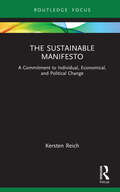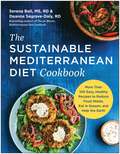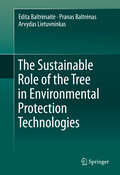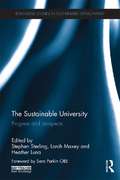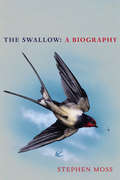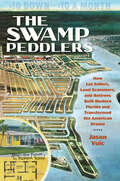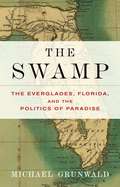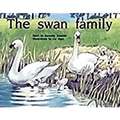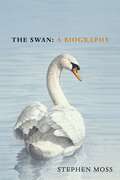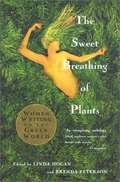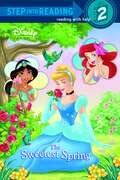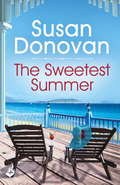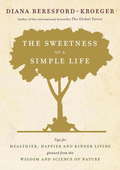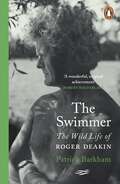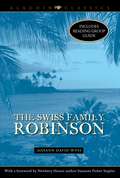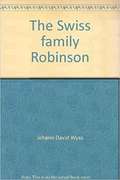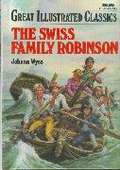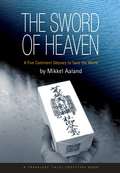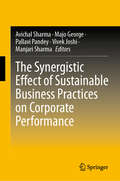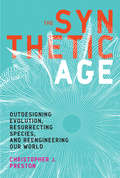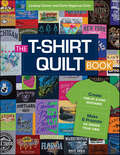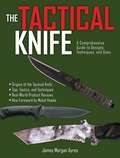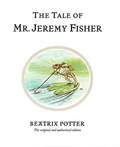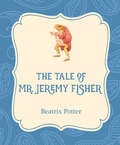- Table View
- List View
The Sustainable Manifesto: A Commitment to Individual, Economical, and Political Change (Routledge Focus on Environment and Sustainability)
by Kersten ReichIn The Sustainable Manifesto, Kersten Reich describes in a concise and memorable way the necessary actions that humans need to take to live sustainably and combat climate change. Are we sufficiently capable of changing our behaviour towards sustainability? What do we have to do in a more sustainable way, and how? The Sustainable Manifesto considers questions around behaviour-change and action for sustainability and connects this thinking to current research in both the natural and human sciences. Reich begins by addressing the most important risks to sustainability and looks in particular at climate change, biodiversity, land use and global phosphorus and nitrogen cycles. He goes on to identify the main causes that have led to the current crisis: specifically the human desire for expansion, growth in all areas, progress and competitive advantages that have forced consideration of the common good into the background. In this vein, the author highlights how economics and politics are two driving forces for which sustainability is difficult to comprehend, going against their basic principles of a liberal and now neo-liberal expansion of all markets. Finally, Reich demonstrates how sustainability could be possible if we reprioritize our life goals and face the reality of an ecological crisis and the necessary transformation of society in order to save our planet. Innovative and accessible, this book will be of interest to students and researchers of sustainability, theories of learning, human behaviour, as well as those who are looking for answers on how to fight for a sustainable future.
The Sustainable Mediterranean Diet Cookbook: More Than 100 Easy, Healthy Recipes to Reduce Food Waste, Eat in Season, and Help the Earth
by Deanna Segrave-Daly Serena BallMouthwatering, budget-friendly recipes that are good for you and good for the Earth, from the authors of The 30-Minute Mediterranean Diet Cookbook Food-loving dietitians and culinary instructors Serena Ball and Deanna Segrave-Daly are back, serving up delicious climate cuisine with a Mediterranean spin. The science is clear: a Mediterranean-style diet is one of the healthiest and most sustainable in the world. The Sustainable Mediterranean Diet Cookbook is a comprehensive guide to getting the most from this incredible regimen, with 10 steps to a more eco-friendly kitchen including helpful guidance on more sustainable ingredient choices, energy-saving cooking methods, smarter storage, and food waste reduction. If you can&’t do all 10, don&’t worry! Making even a few of these small changes can add up to a big impact on the health of the planet. Recipes include: Tahini Swirl Yogurt Parfait with Grapes Broiled Halloumi with Mint Cucumber Salad Cheesy Broccoli and Greens Soup with Za&’atar (or Any Day Bouillabaisse) Mascarpone Scrambled Eggs with Carrot Bacon Turkish Tomato Flatbread Falafel with Pickled Herb Spread Little Fishes Red Pepper Potato Cakes OR Spicy Fish Shawarma Bowl Smoked Seafood Farro Risotto North African Chicken Couscous Bowls Parsley Pistachio Beef Bulgur Koftas Baklava Frozen Yogurt Bark Olive Oil Polenta Berry Cakes Each recipe includes detailed nutritional information, as well as helpful ingredient substitutions, prep tips, and time-saving suggestions. Recipes were triple-tested by real home cooks and are adaptable for gluten-free, dairy-free, egg-free, nut-free, vegetarian and vegan lifestyles. Meat and seafood lovers will also find approachable ways to make more eco-conscious choices. With beautiful, inspiring full-color photographs throughout, this cookbook is an indispensable resource for a climate-friendly kitchen.
The Sustainable Role of the Tree in Environmental Protection Technologies
by Edita Baltrėnaitė Pranas Baltrėnas Arvydas LietuvninkasThis monograph describes ways of using trees and their byproducts in environmental protection technologies and methodologies throughout their lifecycles. The tree, the planet's main source of biomass, is an indispensable tool for sustainable technologies, and the authors present a holistic picture of how and why in this volume. The authors describe the indispensable role of the living tree in phytoremediation and biomonitoring and detail the relationship of the tree with its surrounding ecosystem. The direct and indirect relationships of a tree at its vegetation period with various components of the ecosystem (i. e. atmosphere, hydrosphere, lithosphere and soil) contribute to the role of a tree as the medium for integrating aerogenic and edaphic pollutants. Trees phytostabilize pollutants in their organisms and remove them from the soil. The ability of some species of trees to reflect the quality of the environment makes a basis for the environmental bioindication, while quantitative representation of the chemical composition of the surrounding environment allows for the use of trees in biomonitoring. Morphological features of trees (e. g. annual tree rings) allow us to observe environmental conditions in the past and retrospectively evaluate them. This monograph also details how wood products (e. g. biochar, chips, bark, etc. ) of a tree after it has died are used in environmental technologies. Due to the specific morphological form and physical and chemical composition of wood products, they may be used as active materials in the technologies aimed at reducing pollution in an effective and sustainable manner.
The Sustainable University: Progress and prospects (Routledge Studies in Sustainable Development)
by Stephen Sterling Larch Maxey Heather LunaThe direction of higher education is at a crossroads against a background of mounting sustainability-related issues and uncertainties. This book seeks to inspire positive change in higher education by exploring the rich notion of the sustainable university and illustrating pathways through which its potential can be realised. Based on the experience of leading higher education institutions in the UK, the book outlines progress in the realisation of the concept of the ‘sustainable university’ appropriate to the socioeconomic and ecological conditions facing society and graduates. Written by leading exponents of sustainability and sustainability education, this book brings together examples, insight, reflection and strategies from the experience of ten universities, widely recognised as leaders in developing sustainability in higher education. The book thus draws on a wealth of experience to provide reflective critical analysis of barriers, achievements, strategies and potential. It critically reviews the theory and practice involved in developing the sustainable university in a systemic and whole institutional manner, including the role of organisational learning.While remaining mindful of the challenges of the current climate, The Sustainable University maps out new directions and lines of research as well as offering practical advice for researchers, students and professionals in the fields of management, leadership, organisational change, strategy and curriculum development who wish to take this work further.
The Swallow: A Biography (Shortlisted for the Richard Jefferies Society and White Horse Bookshop Literary Award) (The Bird Biography Series #3)
by Stephen MossFrom the bestselling author of The Robin, The Wren and The Twelve Birds of Christmas. With around 700,000 breeding pairs, the swallow is one of the most familiar birds in Britain. Though we consider the swallow to be 'our' bird, we also share this beloved creature with millions of others across the globe. Whilst we see it on a daily basis for half the year, the swallow then flies south to Africa, living on only in our memory in the long, dark winter.In The Swallow Stephen Moss documents a year of observing the swallow close to home and in the field to shed light on the secret life of this extraordinary bird. We trace the swallow's life cycle and journey, including the epic 12,000-mile round trip it takes every year, to enable it to enjoy a life of almost eternal sunshine, and the key part the swallow plays in our traditional and popular culture.With beautiful illustrations throughout, this captivating year-in-the-life biography reveals the hidden secrets of this charismatic and beautiful bird.PRAISE FOR STEPHEN MOSS: 'A superb naturalist and writer' Chris Packham'Inspired, friendly and blessed with apparently limitless knowledge' Peter Marren'Moss has carved out an enviable niche as a chronicler of the natural world' Daily Mail
The Swamp Peddlers: How Lot Sellers, Land Scammers, and Retirees Built Modern Florida and Transformed the American Dream
by Jason VuicFlorida has long been a beacon for retirees, but for many, the American dream of owning a home there was a fantasy. That changed in the 1950s, when the so-called "installment land sales industry" hawked billions of dollars of Florida residential property, sight unseen, to retiring northerners. For only $10 down and $10 a month, working-class pensioners could buy a piece of the Florida dream: a graded home site that would be waiting for them in a planned community when they were ready to build. The result was Cape Coral, Port St. Lucie, Deltona, Port Charlotte, Palm Coast, and Spring Hill, among many others—sprawling communities with no downtowns, little industry, and millions of residential lots. In The Swamp Peddlers, Jason Vuic tells the raucous tale of the sale of residential lots in postwar Florida. Initially selling cheap homes to retirees with disposable income, by the mid-1950s developers realized that they could make more money selling parcels of land on installment to their customers. These "swamp peddlers" completely transformed the landscape and demographics of Florida, devastating the state environmentally by felling forests, draining wetlands, digging canals, and chopping up at least one million acres into grid-like subdivisions crisscrossed by thousands of miles of roads. Generations of northerners moved to Florida cheaply, but at a huge price: high-pressure sales tactics begat fraud; poor urban planning begat sprawl; poorly-regulated development begat environmental destruction, culminating in the perfect storm of the 21st-century subprime mortgage crisis.
The Swamp: The Everglades, Florida, and the Politics of Paradise
by Michael GrunwaldThe Everglades was once reviled as a liquid wasteland, and Americans dreamed of draining it. Now it is revered as a national treasure, and Americans have launched the largest environmental project in history to try to save it. The Swamp is the stunning story of the destruction and possible resurrection of the Everglades, the saga of man's abuse of nature in southern Florida and his unprecedented efforts to make amends. Michael Grunwald, a prize-winning national reporter for The Washington Post, takes readers on a riveting journey from the Ice Ages to the present, illuminating the natural, social and political history of one of America's most beguiling but least understood patches of land. The Everglades was America's last frontier, a wild country long after the West was won. Grunwald chronicles how a series of visionaries tried to drain and "reclaim" it, and how Mother Nature refused to bend to their will; in the most harrowing tale, a 1928 hurricane drowned 2,500 people in the Everglades. But the Army Corps of Engineers finally tamed the beast with levees and canals, converting half the Everglades into sprawling suburbs and sugar plantations. And though the southern Everglades was preserved as a national park, it soon deteriorated into an ecological mess. The River of Grass stopped flowing, and 90 percent of its wading birds vanished. Now America wants its swamp back. Grunwald shows how a new breed of visionaries transformed Everglades politics, producing the $8 billion rescue plan. That plan is already the blueprint for a new worldwide era of ecosystem restoration. And this book is a cautionary tale for that era. Through gripping narrative and dogged reporting, Grunwald shows how the Everglades is still threatened by the same hubris, greed and well-intentioned folly that led to its decline.
The Swan Family: Individual Student Edition Blue (levels 9-11)
by Beverley RandellA Father swan protects his family with his neck, feathers, and wide wing span. Swan Family Grade 1: Rigby PM Plus Blue, Student Reader (Level 10)
The Swan: A Biography (The Bird Biography Series #4)
by Stephen MossFrom the renowned naturalist Stephen Moss comes the must-have gift for bird lovers this Christmas. 'Wherever there is a stretch of water for them to find food and make their nest, you will come across swans' With beautiful illustrations throughout, this eye-opening biography reveals the hidden secrets of one of Britain's best-known birds. The Mute Swan is not so much a bird, as a national treasure: the avian equivalent of Sir David Attenborough or the Queen. These huge and stately creatures are part of our urban and rural landscapes, a constant presence on lakes, rivers and ponds throughout Britain. Yet despite their familiarity, they are often misunderstood; and while many people love swans, others fear them. Swans also feature in myths and legends, art and literature, dance and music, not just in Britain but all around the world. Stephen Moss delves into the facts and fiction about these charismatic birds, describes their seasonal life cycle and examines their central role in our history and culture. He also includes stories about 'wild swans' - Whooper and Bewicks - that visit us in winter; and the Black Swan of Australia. 'A superb naturalist and writer' Chris Packham 'Moss has carved out an enviable niche as a chronicler of the natural world' Daily Mail
The Sweet Breathing of Plants: Women Writing on the Green World
by Linda Hogan Brenda PetersonA few chapters are: A Passion for Plants--Susan Orlean, Orchid Fever--Sharman Russell, Smelling Like A Rose--Isabel Allen, Ode to Mold--Linda Hasselstrom, Mulch--Zora Neale Hurston, and my favorite: The Language of flowers by Claudia Lewis, in which we learn how the Victorians carried out their love correspondence solely with flowers. This is a fascinating book.
The Sweetest Spring (Step into Reading)
by Apple JordanShare the sweetness of spring with Cinderella, Ariel, and all the Disney Princesses in this fun and bouncy Step 2 reader. This delightful story with bright and beautiful illustrations will have budding young princess fans blossoming into wonderful readers.
The Sweetest Summer: Bayberry Island Book 2 (Bayberry Island)
by Susan DonovanNew York Times bestselling author Susan Donovan returns to Bayberry Island, where a bronze mermaid statue could be the cause of heartbreak or everlasting romance for a practical-minded police chief and his first love. Perfect for fans of Susan Elizabeth Phillips, JoAnn Ross and Jill Shalvis.Every instinct tells Police Chief Clancy Flynn that his island's claim to fame is nothing but a silly tourist attraction. Still, he can't help but wonder if his lifetime of bad romances - starting with the pretty tourist who broke his twelve-year-old heart - could be traced back to a childhood prank involving that very statue...Then one day the pretty tourist comes barrelling back into Bayberry - all grown-up and on the run with her niece. Though Evelyn McGuinness is wanted for kidnapping, she tries to persuade Clancy that there's more to the story. Now the by-the-book police chief must make the toughest decision of his life: to take Evelyn into custody - or into his arms...Don't miss more irresistible Bayberry Island romance with Rowan's story in Sea of Love and Duncan's story in Moondance Beach.
The Sweetness of a Simple Life
by Diana Beresford-KroegerThe author of The Global Forest--an international bestseller and a classic upon publication, beloved by readers around the world--gives us her tips and advice for achieving better health and peace of mind, with frugality, simplicity and pleasure not far behind. In The Sweetness of a Simple Life, Diana Beresford-Kroeger mixes science with storytelling, wonderment, magic, myth and plenty of common sense. Orphaned at an early age, Beresford-Kroeger was raised by elderly relatives in Ireland in the Druidic tradition, taught the overlap between the arts and sciences, and the triad of body, mind and spirit. After pursuing a PhD in medical biochemistry, Beresford-Kroeger set out on a quest to preserve the world's forests. In this warm and wise collection of essays, she gives us a guide for living simply and well: which foods to eat and which to avoid; how to clean our homes and look after pets; how we can protect ourselves and our loved ones from illness; and why we need to appreciate nature. She provides an easy dose of healing, practical wisdom, blending modern medicine with aboriginal traditions. This inspiring, accessible book emphasizes back to basics, with the touchstone not an exotic religion or meditation practice, but the natural world around us.
The Swimmer: The Wild Life of Roger Deakin
by Patrick BarkhamBEST BOOK OF 2023 ACCORDING TO THE NEWSTATESMAN AND OBSERVER'The Swimmer is a wonderful, original achievement; teeming with stories, glittering with images, and experimental in form and tone' Robert MacfarlaneRoger Deakin, author of the immortal Waterlog, was a man of many parts: maverick ad-man, cider-maker, teacher, environmentalist, music promoter and filmmaker. But, above all, he was the restorer of ancient Walnut Tree Farm in Suffolk, the heartland where he wrote about all natural life – with rare attention, intimacy, precision and poetry.Roger Deakin was unique, and so too is this joyful work of creative biography, told primarily in the words of the subject himself, with support from a chorus of friends, family, colleagues and lovers. Delving deep into Deakin’s library of words, Patrick Barkham draws from notebooks, diaries, letters and recordings to conjure his voice back to glorious life in these pages.'A rich, strange and compelling work of creative memoir that beautifully honours and elevates the life and work of its subject' Alex Preston, Observer
The Swiss Family Robinson
by Suzanne Fisher Staples Johann David WyssOriginally written to entertain his four young sons, Johann David Wyss based The Swiss Family Robinson on Daniel Defoe's classic shipwreck story, Robinson Crusoe (1719). Upon its initial publication in 1812, The Swiss Family Robinson was received with great enthusiasm not only as a first-rate adventure story, but also as a practical guide to self-sufficiency.
The Swiss Family Robinson
by Suzanne Fisher Staples Johann David WyssOriginally written to entertain his four young sons, Johann David Wyss based The Swiss Family Robinson on Daniel Defoe's classic shipwreck story, Robinson Crusoe (1719). Upon its initial publication in 1812, The Swiss Family Robinson was received with great enthusiasm not only as a first-rate adventure story, but also as a practical guide to self-sufficiency.
The Swiss Family Robinson
by Johann David Wyss William Henry Giles KingstonWhen a Swiss couple and their four sons are shipwrecked on an isolated island, they adapt to their "New Switzerland" using many imaginative methods of farming and animal taming.
The Swiss Family Robinson (Great Illustrated Classics)
by Johann WyssShipwrecked on a tropical island, a Swiss minister, his wife, and four sons struggle to survive until they can be rescued.
The Sword of Heaven
by Mikkel Aaland"Any attempt at peace must be attended by a knowledge of self," discovers writer and photographer Mikkel Aaland, who grew up with a bomb shelter for a bedroom, in terror of nuclear war. At the height of the Cold War, Aaland finds himself drawn into a mysterious Shinto priest's plan to save the world. Traveling from Norway to the Philippines, Iceland to South Africa, he places pieces of a sacred Shinto sword in key power spots around the world. Along the way, he comes face to face with his deepest childhood fears of war and destruction, encounters the compelling and mysterious Shinto religion, struggles with the uncertainties of love, and learns to face life with an open heart.The Sword of Heaven tells the extraordinary true story of a journey in which all boundaries are pushed-geographical, cultural, and personal-and in which the healing of the world and the healing of one man appear to be inextricably linked.
The Synergistic Effect of Sustainable Business Practices on Corporate Performance
by Manjari Sharma Avichal Sharma Majo George Pallavi Pandey Vivek JoshiThis book explores the intricate relationship between sustainable business practices and economic performance. By examining how companies can achieve financial benefits through the integration of environmental and social responsibility into their core strategies, this book seeks to bridge the gap between environmental and economic concerns. It demonstrates that sustainability is not merely a moral imperative but a strategic economic driver in the modern business landscape. The book provides valuable insights into how companies can align their economic goals with environmental and social responsibilities, leading to long-term financial success. Readers will also benefit from the practical applications and case studies that demonstrate the tangible financial benefits of sustainable business practices. Additionally, the book serves as a resource for implementing sustainability strategies within organizations, making it an indispensable guide for business leaders, policymakers, and academics seeking to navigate the complexities of modern economic and environmental challenges.
The Synthetic Age: Outdesigning Evolution, Resurrecting Species, and Reengineering Our World (The\mit Press Ser.)
by Christopher J. PrestonImagining a future in which humans fundamentally reshape the natural world using nanotechnology, synthetic biology, de-extinction, and climate engineering.We have all heard that there are no longer any places left on Earth untouched by humans. The significance of this goes beyond statistics documenting melting glaciers and shrinking species counts. It signals a new geological epoch. In The Synthetic Age, Christopher Preston argues that what is most startling about this coming epoch is not only how much impact humans have had but, more important, how much deliberate shaping they will start to do. Emerging technologies promise to give us the power to take over some of Nature's most basic operations. It is not just that we are exiting the Holocene and entering the Anthropocene; it is that we are leaving behind the time in which planetary change is just the unintended consequence of unbridled industrialism. A world designed by engineers and technicians means the birth of the planet's first Synthetic Age.Preston describes a range of technologies that will reconfigure Earth's very metabolism: nanotechnologies that can restructure natural forms of matter; “molecular manufacturing” that offers unlimited repurposing; synthetic biology's potential to build, not just read, a genome; “biological mini-machines” that can outdesign evolution; the relocation and resurrection of species; and climate engineering attempts to manage solar radiation by synthesizing a volcanic haze, cool surface temperatures by increasing the brightness of clouds, and remove carbon from the atmosphere with artificial trees that capture carbon from the breeze. What does it mean when humans shift from being caretakers of the Earth to being shapers of it? And in whom should we trust to decide the contours of our synthetic future? These questions are too important to be left to the engineers.
The T-Shirt Quilt Book: Recycle Your Tees into One-of-a-Kind Keepsakes
by Carla Hegeman Crim Lindsay ConnerNext stop, memory lane! Turn treasured tees into something brand new—a T-shirt quilt! Capture the memories of a special time, starting with a quick pillow project or a baby quilt made from onesies, and work your way up to bed quilts in multiple sizes. Learn the secrets to choosing shirts, centering and cutting out around a logo, working with shirts that are too small, and interfacing knit fabrics with finesse. You'll practice your skills with 8 projects ranging from simple squares to pieced stars and triangles, plus easy machine-appliquéd motifs. With beginner-friendly designs and truly unique layouts to entice experienced quilters, this essential guide to T-shirt quilts covers all the bases. • Wrap yourself in the warmth of well-worn tees! Stretch a small collection with other clothing fabric, purchased knits, and quilter’s cotton • Make your first quilt with simple piecing and easy machine appliqué, or try intermediate and advanced layouts • Have no fear of sewing with knits! Finish T-shirt quilts that will stand the test of time
The Tactical Knife: A Comprehensive Guide to Designs, Techniques, and Uses
by Mykel Hawke James Morgan AyresTactical knives are the fast-growing field of American bladesmithing. Now, in one groundbreaking volume, tactical knife expert James Morgan Ayres shares more than four decades of real-world experience with purpose-designed knives. You'll find it all in The Tactical Knife: fixed blades, folders, defensive uses, survival uses, product reviews-in short, everything you need to make an informed decision about your choice of a tactical knife.Newly updated with specifications and reviews for new products as well as new information on recent developments in the field, James Morgan Ayres provides the latest need-to-know info on the subject for first time owners (or potential owners) of tactical knives as well as experts who want the latest intel on new products.Features inside include: Origins of the Tactical Knife The Bowie knife Tactical Knives of the Mid-twentieth Century Steel, Heat Treating, Geometry, Design, Grinds, and Forging Choosing a Tactical Knife Basic Skills, Maintenance, and TacticsComplete with hundreds of detailed color photos, tips, tactics, and techniques, The Tactical Knife is the best book out there for all your tactical knife needs. When choosing a tactical knife, don't guess-know! Keep yourself on the cutting edge-with The Tactical Knife!
The Tale of Mr. Jeremy Fisher
by Beatrix PotterThis is no ordinary fishing trip! "There was a bite almost directly; the float gave a tremendous bobbit!" But this was no minnow, and to find out what it was, you will just have to read this charming story about Mr. Jeremy Fisher (frog) and his friends!
The Tale of Mr. Jeremy Fisher: A Myread Production (Xist Illustrated Children's Classics)
by Beatrix PotterMishaps rain down upon a frog trying to catch something to eat in this splendid story from the perennially popular author of The Tale of Peter Rabbit. The Tale of Mr. Jeremy Fisher is the story of an amiable but accident-prone frog who sets off on a fishing adventure. Written by Beatrix Potter, it is part of the Xist Publishing Children&’s Classics collection. Each ebook has been specially formatted with full-screen, full-color illustrations and the original, charming text.
